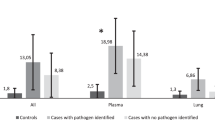Abstract
Postmortem detection of pathogens in infectious deaths is quite important for diagnosing the cause of death and public health. However, it is difficult to detect possible bacterial pathogens in forensic practice using conventional methods like bacterial culture, especially in cases with putrefaction and antibiotic treatment. We report a fatal case caused by necrotizing fasciitis due to bacterial infection. An 8-year-old girl was found dead during sleep 4 days after a minor trauma to her left knee. The gross autopsy suggested that bacterial soft tissue infection might be the cause of death, and the microscopic examination confirmed the diagnosis. The slight putrefaction found at gross autopsy might interfere through postmortem bacterial translocation and reproduction with bacterial culture. High-throughput 16S rDNA sequencing was employed to identify possible pathogens. Bacterial DNA sequencing results suggested Streptococcus pyogenes and Staphylococcus, typical pathogens of necrotizing fasciitis in the tissue. 16S rDNA sequencing might thus be a useful tool for accurate detection of pathogens in forensic practice.






Similar content being viewed by others
References
Cavé H, Acquaviva C, Bièche I, Brault D, de Fraipont F, Fina F et al (2003) RT-PCR in clinical diagnosis. Ann Biol Clin 61(6):635–644
Lagier JC, Edouard S, Pagnier I, Mediannikov O, Drancourt M, Raoult D (2015) Current and past strategies for bacterial culture in clinical microbiology. Clin Microbiol Rev 28(1):208–236. https://doi.org/10.1128/cmr.00110-14
Finley SJ, Benbow ME, Javan GT (2015) Microbial communities associated with human decomposition and their potential use as postmortem clocks. Int J Legal Med 129(3):623–632. https://doi.org/10.1007/s00414-014-1059-0
Prudent E, Raoult D (2019) Fluorescence in situ hybridization, a complementary molecular tool for the clinical diagnosis of infectious diseases by intracellular and fastidious bacteria. FEMS Microbiol Rev 43(1):88–107. https://doi.org/10.1093/femsre/fuy040
de Melo F (2017) do Nascimento C, Souza DO, de Albuquerque RF, Jr. Identification of oral bacteria on titanium implant surfaces by 16S rDNA sequencing. Clin Oral Implants Res 28(6):697–703. https://doi.org/10.1111/clr.12865
Song EJ, Lee ES, Nam YD (2018) Progress of analytical tools and techniques for human gut microbiome research. J Microbiol (Seoul, Korea) 56(10):693–705. https://doi.org/10.1007/s12275-018-8238-5
Xia X, Zhang P, He L, Gao X, Li W, Zhou Y, Li Z, Li H, Yang L (2019) Effects of tillage managements and maize straw returning on soil microbiome using 16S rDNA sequencing. J Integr Plant Biol 61(6):765–777. https://doi.org/10.1111/jipb.12802
Guo J, Fu X, Liao H, Hu Z, Long L, Yan W, Ding Y, Zha L, Guo Y, Yan J, Chang Y, Cai J (2016) Potential use of bacterial community succession for estimating post-mortem interval as revealed by high-throughput sequencing. Sci Rep 6:24197. https://doi.org/10.1038/srep24197
Huang H, Yao T, Wu W, Zhai C, Guan T, Song Y, Sun Y, Xiao C, Liang P, Chen L (2019) Specific microbes of saliva and vaginal fluid of Guangdong Han females based on 16S rDNA high-throughput sequencing. Int J Legal Med 133(3):699–710. https://doi.org/10.1007/s00414-018-1986-2
Idota N, Tsuboi H, Takaso M, Tojo M, Kinebuchi T, Nakamura M, Ichioka H, Shintani-Ishida K, Ikegaya H (2018) Comparison between temperature gradient gel electrophoresis of bacterial 16S rDNA and diatom test for diagnosis of drowning. J Forensic Sci 63(3):752–757. https://doi.org/10.1111/1556-4029.13606
Woo PC, Lau SK, Teng JL, Tse H, Yuen KY (2008) Then and now: use of 16S rDNA gene sequencing for bacterial identification and discovery of novel bacteria in clinical microbiology laboratories. Clin Microbiol Infect 14(10):908–934. https://doi.org/10.1111/j.1469-0691.2008.02070.x
Fox GE, Magrum LJ, Balch WE, Wolfe RS, Woese CR (1977) Classification of methanogenic bacteria by 16S ribosomal RNA characterization. Proc Natl Acad Sci U S A 74(10):4537–4541. https://doi.org/10.1073/pnas.74.10.4537
Chakravorty S, Helb D, Burday M, Connell N, Alland D (2007) A detailed analysis of 16S ribosomal RNA gene segments for the diagnosis of pathogenic bacteria. J Microbiol Methods 69(2):330–339. https://doi.org/10.1016/j.mimet.2007.02.005
Yang B, Wang Y, Qian PY (2016) Sensitivity and correlation of hypervariable regions in 16S rRNA genes in phylogenetic analysis. BMC Bioinforma 17:135. https://doi.org/10.1186/s12859-016-0992-y
Loong SK, Khor CS, Jafar FL, AbuBakar S (2016) Utility of 16S rDNA sequencing for identification of rare pathogenic bacteria. J Clin Lab Anal 30(6):1056–1060. https://doi.org/10.1002/jcla.21980
Muldrew KL, Simpson JF, Stratton CW, Tang YW (2005) Molecular diagnosis of necrotizing fasciitis by 16S rRNA gene sequencing and superantigen gene detection. J Mol Electron 7(5):641–645. https://doi.org/10.1016/s1525-1578(10)60599-5
Olsen RJ, Musser JM (2010) Molecular pathogenesis of necrotizing fasciitis. Annu Rev Pathol 5:1–31. https://doi.org/10.1146/annurev-pathol-121808-102135
Stevens DL, Bryant AE (2017) Necrotizing soft-tissue infections. N Engl J Med 377(23):2253–2265. https://doi.org/10.1056/NEJMra1600673
Bode-Jänisch S, Schütz S, Schmidt A, Tschernig T, Debertin AS, Fieguth A, Hagemeier L, Teske J, Suerbaum S, Klintschar M, Bange FC (2013) Serum procalcitonin levels in the postmortem diagnosis of sepsis. Forensic Sci Int 226(1-3):266–272. https://doi.org/10.1016/j.forsciint.2013.01.041
He M, Hong T, Lauro P, Pinar H (2011) Identification of bacteria in paraffin-embedded tissues using 16S rDNA sequencing from a neonate with necrotizing enterocolitis. Pediatr Dev Pathol 14(2):149–152. https://doi.org/10.2350/10-03-0804-cr.1
Heinze S, Püschel K, Tsokos M (2011) Necrotizing fasciitis with fatal outcome: a report of two cases. Forensic Sci Med Pathol 7(3):278–282. https://doi.org/10.1007/s12024-010-9211-8
Fais P, Viero A, Viel G (2018) Necrotizing fasciitis: case series and review of the literature on clinical and medico-legal diagnostic challenges. Int J Legal Med 132(5):1357–1366. https://doi.org/10.1007/s00414-018-1838-0
Rutty GN, Busuttil A (2000) Necrotizing fasciitis: reports of three fatal cases simulating and resulting from assaults. Am J Forensic Med Pathol 21(2):151–154. https://doi.org/10.1097/00000433-200006000-00012
Funding
The work was supported by Guangzhou Sci-Tech Project (Grant No. 201804010307 to Xia Yue).
Author information
Authors and Affiliations
Corresponding author
Ethics declarations
Conflict of interest
The authors declare that they have no conflict of interest.
Informed consent
Informed consent for publishing this case report was obtained from the direct relative of the decedent.
Additional information
Publisher’s note
Springer Nature remains neutral with regard to jurisdictional claims in published maps and institutional affiliations.
Rights and permissions
About this article
Cite this article
Qu, D., Qiao, DF., Klintschar, M. et al. High-throughput 16S rDNA sequencing assisting in the detection of bacterial pathogen candidates: a fatal case of necrotizing fasciitis in a child. Int J Legal Med 135, 399–407 (2021). https://doi.org/10.1007/s00414-020-02421-x
Received:
Accepted:
Published:
Issue Date:
DOI: https://doi.org/10.1007/s00414-020-02421-x




